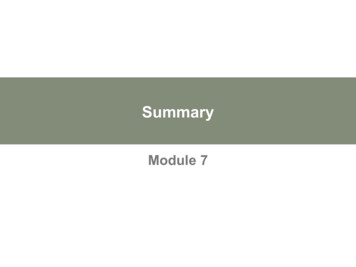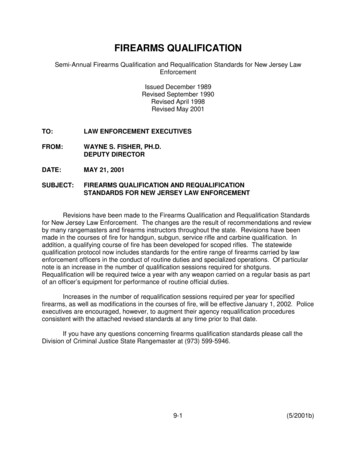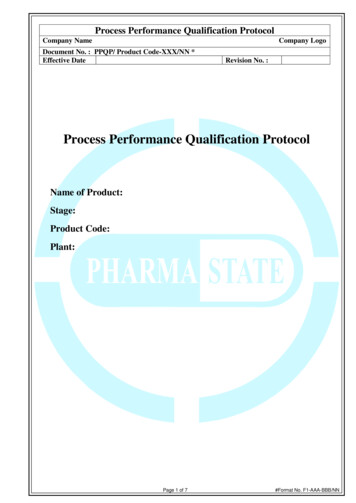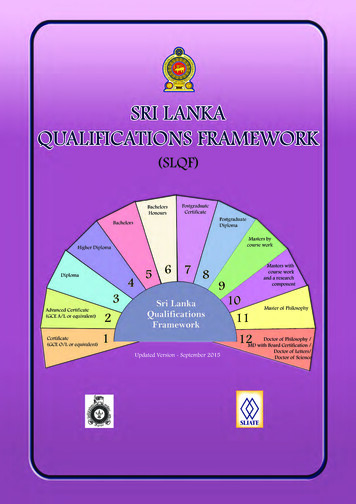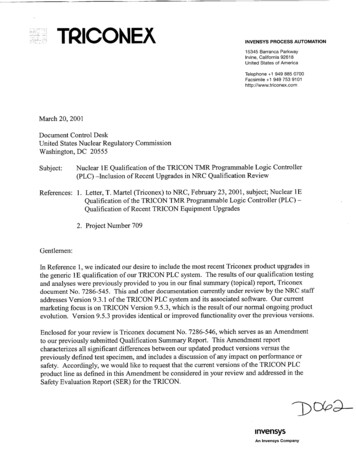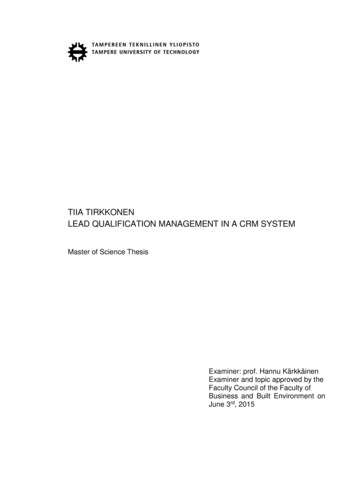
Transcription
TIIA TIRKKONENLEAD QUALIFICATION MANAGEMENT IN A CRM SYSTEMMaster of Science ThesisExaminer: prof. Hannu KärkkäinenExaminer and topic approved by theFaculty Council of the Faculty ofBusiness and Built Environment onJune 3rd, 2015
iABSTRACTTIIA TIRKKONEN: Lead Qualification Management in a CRM SystemTampere University of TechnologyMaster of Science Thesis, 100 pages, 2 Appendix pagesOctober 2015Master’s Degree Programme in Information and Knowledge ManagementMajor: Product and Process ManagementExaminer: Professor Hannu KärkkäinenKeywords: sales management, sales lead, lead qualification, web-to-leadThe purpose of this thesis work was to define guidelines based on which lead managementcould be best supported. The focus of the scope was on how sales should manage theleads once they have been entered into the system, for example, through an online inquiryform. The customer organization was Metso Corporation, a global company specializingin solutions to support modernizing infrastructure.To reach the objectives, both theoretical and empirical research was conducted. Theoretical research was a literature review related to sales lead management and informationelements tied to sales leads. While focus was on the handling of leads, the full lead management process from lead generation to customer relationship management was considered where applicable. Knowledge related to leads were investigated, as well as transaction and activity information that could be tied to leads. Empirical research was conductedthrough interviews with sales and marketing management and participant observation.Experiences and requirements related to lead management were the main topics of discussion. Analysis of interviews and observation was conducted inductively and resultsgrouped on the high level by research question themes.By identifying themes and combining the findings with those in existing literature, research questions were answered. The requirements and roles involved in lead management were solved, as well as what kinds of information is tied to leads and how theirquality could be evaluated and improved. It was found that to best support sales’ leadmanagement work at Metso, the CRM system should be configured to support collaboration between different stakeholders. Collaboration was seen as an important part of beingable to manage leads through information.While collaboration is already something done between sales, marketing and other stakeholders in lead management, the information systems currently in use do not fully supportthe whole process. For better end-to-end process visibility, the existing web lead management system should be migrated onto the same platform as other CRM activities. Thisallows for connecting sales to lead sources. The CRM system’s usability should also bedeveloped to support collaboration. Collaboration involves a lot of knowledge that is tiedto individuals. Utilizing this tacit knowledge in qualifying leads can help systemize theprocess and give better standardized information about leads to both management and thesales representatives managing them.
iiTIIVISTELMÄTIIA TIRKKONEN: Leadien kvalifioinnin hallinta CRM-järjestelmässäTampereen teknillinen yliopistoDiplomityö, 100 sivua, 2 liitesivuaLokakuu 2015Tietojohtamisen diplomi-insinöörin tutkinto-ohjelmaPääaine: Tuote- ja prosessitiedon hallintaTarkastaja: professori Hannu KärkkäinenAvainsanat: myyntijohtaminen, myyntileadi, leadien kvalifiointi, web-to-leadTämän diplomityön tarkoitus on määritellä suosituksia, joiden perusteella myyntileadejävoisi parhaiten kvalifioida ja hallita. Työ on rajattu käsittelemään myynnin osuuttaleadienhallintatyöstä eli käytännössä kuinka leadejä tulisi käsitellä, kun ne on syötettyjärjestelmään esimerkiksi verkossa olevan tiedustelulomakkeen kautta. Asiakasyritystyössä on Metso Oyj, joka on erikoistunut infrastruktuuria nykyaikaistaviin ratkaisuihin.Tutkimus suoritettiin teoreettisesti ja empiirisesti. Teoreettinen tutkimus olikirjallisuuskatsaus liittyen myyntileadien hallintaan sekä leadeihin liittyviininformaatioelementteihin. Vaikka työ oli rajattu leadien käsittelyvaiheeseen, kokoleadienhallintaprosessi on huomioitu tarpeen mukaan. Työssä tutkittiin leadeihin liittyväätietoa sekä aktiviteettitietoja, jotka voitiin sitoa leadeihin. Empiirinen tutkimus sisälsihaastatteluja myynnin ja markkinoinnin johdon kanssa sekä havainnointia. Aiheina olivatheidän osaamisensa ja tarpeensa leadienhallintaan liittyen. Tutkimuksen analyysi tehtiininduktiivisesti ja tulokset ryhmiteltiin tutkimuskysymysten teemojen mukaan.Tutkimuskysymyksiin saatiin vastattua tunnistamalla teemoja ja yhdistämällä nelöydöksiin kirjallisuudesta. Työssä selvitettiin vaatimuksia ja rooleja liittyenleadienhallintaan. Lisäksi tutkittiin millaista tietoa leadeihin on sidottu ja miten niidenlaatua voisi arvioida ja kehittää. Tuloksena voitiin todeta, että ikutusta. Vuorovaikutus nähtiin tärkeänä osana kyvykkyyttä hallita leadejä tiedonavulla.Vuorovaikutusta tapahtuu jo myynnin, markkinoinnin ja muiden osapuolien välillä, muttanykyiset tietojärjestelmät eivät täysin tue koko prosessia. Nykyinenleadienhallintajärjestelmä tulisi siirtää samalle alustalle muiden asiakkuudenhallintaanliittyvien aktiviteettien kanssa, jotta saavutettaisiinparempi näkyvyys kaikkiinmyyntiprosessin vaiheisiin. Järjestelmän käytettävyyttä tulisi myös kehittää tukemaanvuorovaikutusta ja yhteistyöskentelyä. Vuorovaikutukseen liittyy paljon tietoa, joka onsidottu yksilöihin. Tämän hiljaisen tiedon hyödyntämistä leadien kvalifioinnissa voiauttaa prosessin systematisoinnissa ja antaa paremmin standardoitua tietoa leadeistä sekäjohdolle että niitä hallinnoiville myyjille.
iiiPREFACEThis Master of Science thesis was completed for Metso Corporation while working in theGlobal Applications team of Metso Business Information Technology Services, underMetso Shared Services. The research was done in close collaboration with the Customerand Marketing Operations team responsible for sales lead generation and lead management processes and systems.I would like to thank Esko Harjama and Sami Olejniczak from Metso for their guidanceand support throughout the research. With their help, the topic and scope of the thesis wasdefined in a way that it would support other initiatives and future development targets inthe organization. They have also provided ideas, input and materials throughout the process, as well as helped find and contact interview participants. Interview participants alsosignificantly contributed to this research, and I would therefore like to thank them againfor their participation as well.Professor Hannu Kärkkäinen from Tampere University of Technology has also providedguidance for the thesis, sparring me to develop the ideas and findings in the thesis to beable to provide the best possible results. For this, I would like to thank him for the adviceand help throughout the process.The rest of you, you’re great as well.Tampere, 17.9.2015Tiia Tirkkonen
ivCONTENTS1.INTRODUCTION . 11.1 Background of the research . 11.2 Objectives and research questions. 31.3 Research methodology . 51.4 Structure . 82. SALES LEAD MANAGEMENT . 92.1 What is a lead? . 92.2 Lead qualification . 122.3 Roles in the prospecting process . 223. INFORMATION IN LEADS. 283.1 Data and information variables . 283.2 Evaluating lead information quality . 333.3 Analytics in lead management . 374. RESEARCH METHODS AND MATERIAL . 424.1 Developing the lead management system . 424.2 Customer organization . 444.3 Data collection methods . 454.3.1Interviews . 474.3.2Observation . 504.4 Analysis methods . 525. RESULTS . 555.1 Requirements for successful lead management . 555.2 Roles in lead management. 595.3 Data and information in leads . 655.4 Evaluating and using lead information. 706. DISCUSSION OF RESULTS . 736.1 Requirements for successful lead management . 736.2 Roles in lead management. 786.3 Data and information in leads . 806.4 Evaluating and using lead information. 826.5 Information system requirements . 847. CONCLUSIONS . 897.1 Research conclusions . 897.2 Evaluation of the research and results . 947.3 Further research topics . 96REFERENCES. 98APPENDIX A: Interview outline
vLIST OF FIGURESFigure 1.Figure 2.Figure 3.Figure 4.Figure 5.Figure 6.Figure 7.Figure 8.Figure 9.Figure 10.Figure 11.Figure 12.Figure 13.Figure 14.Figure 15.Figure 16.Figure 17.Figure 18.Figure 19.Figure 20.Figure 21.Figure 22.Figure 23.Figure 24.Figure 25.Figure 26.Figure 27.Figure 28.Figure 29.Figure 30.Figure 31.Figure 32.Figure 33.Figure 34.Figure 35.Figure 36.Research scope. . 4Research methodology described with the research ‘onion’. . 7Thesis structure. . 8Example of a sales funnel (e.g. Ross & Tyler 2012, p. 119). . 10Ideal customer targeting funnel (Ross & Tyler 2012, p. 47). . 11The REAN framework (adapted from Jackson 2009, p. 27). . 13Relationship development matrix (Dannenberg & Zupancic 2010,p. 118; Ross & Tyler 2012, p. 47). . 15The customer interaction cycle (Roberts-Phelps 2001, p. 57). . 16The lead lifecycle by Marketo (Ross & Tyler 2012, p. 126). . 17Customer’s buying process as criteria for lead qualification(Monat 2011, p. 184). . 21Example of core sales roles (Ross & Tyler 2012, p. 37). . 23The buying funnel (Kotler et al. 2006, p. 11). . 24A prospecting relationship model (Jolson & Wotruba 1992, p. 62). . 26Hierarchy of data, information, knowledge and wisdom. . 34SECI framework (Nonaka et al. 2000, pp. 9-12). . 35REAN segmentation activities (Jackson 2009, p. 150). . 38The insight model (Jackson 2009, p. 188). . 40Reporting process for analysts (Jackson 2009, p. 239). . 41Developing and introducing an information management system(Homburg et al. 2001, p. 157). . 423-Phase Lead Scoring Implementation (DemandGen Report 2014). . 44New Metso level sales process. . 45Researcher roles in observation (Saunders et al. 2009, p. 293). . 51Classification of interview data. . 54Lead management process in the existing Metso system. 56Requirements for successful lead management. . 59Process flow of roles in the lead management process. . 64Roles in the lead management process. . 65Sales inquiry form on Metso’s public website. . 66New lead form in Metso’s current web lead management system. 67Data and information in leads. . 69Lead quality and analysis. . 72The customer targeting funnel for Metso. . 73REAN reporting metrics example. . 74Lead assignment flow and roles. . 78Lead management process simplified. 87Guidelines for lead qualification management. . 93
viLIST OF TABLESTable 1.Table 2.Table 3.Table 4.Table 5.Table 6.Characteristics related to leads (according to Monat 2011, pp.180-182). . 31Information quality dimensions in the AIMQ framework (Lee et al.2002). . 36Data quality checklist (Jackson 2009, p. 145). . 37Interview participants in the customer organization. 49Responsibilities in the lead management process. . 64Lead management system requirements. . 86
11. INTRODUCTION1.1Background of the researchData. A word heard almost daily in this age, partly due to the amounts and ways in whichit is being produced and stored for use. (Roberts-Phelps 2001, p. 51; Ramakrishnan et al.2006, pp. 1-2; Linoff & Berry 2011, pp. 12-13) Data, by definition, is often linked tocomputers and programming, where it acts as a piece or pieces to work with (World Encyclopedia 2004; Law 2009; Chandler & Munday 2011). Sources also cite that data initself is meaningless without association to other information, and the removal of thatother information is what allows data to be compressed into a form that can easily be readby computer programs (Daintith & Wright 2008; Chandler & Munday 2011). Patterns indata can also create information, but it is crucial to recognize which information is actually useful and when data is being collected at the correct level of detail (Linoff & Berry2011, pp. 47-49).Marketing functions aim to actively produce data about potential customers through different channels, such as trade shows and company web sites, for sales representatives tofollow up on (Collins 1985, p. 77; SiriusDecisions Inc. 2006, according to Sabnis et al.2013, p. 52). The data can be entered into databases and applications where sales managers can dynamically track and manage cases all the way to after-sales. The quality of theprospect data can also be tracked in these systems. (Collins 1985, p. 77) According toCollins (1985), these types of systems in general improve sales representatives’ productivity and ability to manage leads. It is, however, important that the systems can be utilized to provide relevant and correct information about the customer’s requirements andpotential in addition to basic data, such as addresses and contact details. If information isnot valid, a customer with potential may be categorized incorrectly and therefore overlooked. (Homburg et al. 2001, p. 8)When potential customers enter their information into a web inquiry form, it can be seenas a sales lead. Sales leads can also be identified through a number of other sources, suchas customer visits, trade shows and company events. (E.g. Erschik 1989; Monat 2011;Salesforce 2015a) In general, if interest towards a certain group of products or servicescan be identified, it can be considered a lead. Different definitions and levels of salesleads are explored further in chapter 2. The terms sales lead and lead are used most synonymously in this thesis.As sales’ workload is constantly high, it is important to efficiently recognize which leadsare the ones that should be nurtured (Homburg et al. 2001, p. 34; Dannenberg & Zupancic
22010; Monat 2011, p. 192). If not managed wisely, more than half of a sales representative’s prospecting time could be spent unproductively or on sorting an abundance of generated leads that have not been qualified before being sent onward (Erschik 1989, p. 28;Jolson & Wotruba 1992, p. 59). Otherwise, the selling company is at risk of providing amass of customers with equally poor service, instead of providing excellent service to thefew customers with the most buying potential (Homburg et al. 2001, p. 7). Finding theright customers to sell to already at an early stage in the sales process has been proven togenerate profit (Jolson & Wotruba 1992, p. 65; Hutt & Speh 2013, p. 222). This oftenrequires doing qualification work on the inquiry before it is forwarded to sales (Erschik1989, p. 29). Additionally, sales and marketing should be in alignment of what a qualifiedlead is like that can be delegated onward to sales representatives for further actions (DemandGen Report 2014, p. 7).In the fall of 2014, Salesforce sent out a survey to marketers globally and received morethan 5000 responses about the state of digital marketing in companies. In business-tobusiness (B2B) marketing, the quality of leads was seen as one of the top three challengesthat business is facing globally, with customer acquisition following closely behind.(Salesforce 2015b) In a study by DemandGen Report (2014), only a third of marketerssurveyed were scoring and qualifying their leads, meaning that most leads were beingforwarded to sales directly. As the number of leads being entered into systems increasesalong with sales’ overall workload, lead prioritization may not be getting enough attention. By excluding unqualified leads from entering the lead management process, productivity and conversion rates of leads to actual sales opportunities should increase (Eloqua2015).While software is not the solution to lead management, processes can be supported bysystems when trained and used strategically (Homburg et al. 2001, p. 205; Dannenberg& Zupancic 2009, pp. 17-18; Hutt & Speh 2013, p. 73). Lead generation can be expensive,and not utilizing means to take full advantage of them will result in a waste of resources(Erschik 1989; Jackson 2009). This thesis focuses on how and what information aboutthe lead reaches sales, and what they can effectively do about it with the help of bothsystems and processes. According to Erschik (1989, p. 28), this has tended to be a topicthat has been neglected. While systems exist and leads are generated through marketingefforts, how they are qualified and handled may not be given enough attention.The customer organization for this thesis is Metso Corporation, a global B2B company,which is in many ways in a transition phase at the time the thesis is being done. There aremajor changes ongoing in the company’s infrastructure, including the divestment of theProcess Automation Solutions business line to Valmet as well as reorganization of manyfunctions to better support business. At the same, many information technology systemsare being renewed and development is fast-paced. Strategic changes have also provokedother initiatives, especially in the sales organization.
3In the customer organization, there is an ongoing initiative to develop sales throughoutall business areas to be more proactive instead of reactive, and overall for business tobecome more customer centric. According to Ross & Tyler (2012, p. 4), this developmentis not an easy one, and often requires new systems and ways of working. Having supportfor the initiative all the way from corporate strategy gives better chances of succeeding(Dannenberg & Zupancic 2009, p. 22). Then main focus of the program so far has beento develop and implement a unified process for sales organizations and customer relationship management (CRM) system where they can track sales cases, forecast sales and collaborate on their work globally.Lead management has not yet been tackled within the program, but lead management issupported by functionality in the new cloud-based CRM system, Salesforce, and willtherefore eventually be migrated there from the legacy platform. Salesforce is considereda leading provider of CRM solutions (e.g. Hutt & Speh 2013, p. 205; Desisto 2014). It isconsidered important that any tools are included in overall concept planning, to avoidhaving disconnected systems that are not able to fully support the business functions thatit should (Homburg et al. 2001, p. 22). The same applies here – as sales is moving towardsusing one system for other aspects of customer relationship management, it seems onlynatural that lead management would be included as well. When using one system, combining data for reporting visibility should also become easier.In addition to the ongoing CRM program, the customer organization has recently releaseda renewed version of their public web pages and development of them is ongoing. Thenew pages have been designed to better support the generation of sales leads throughdifferent ways of gathering contact information and interests. One of the main ideas hasbeen that the threshold for becoming a lead is quite low. For example, a website visitorcan download a product brochure and leave their contact information, which can be seenas a lead. Once the given information is qualified and possibly enriched with other knowninformation about the contact, the sales organization can be in touch with the potentialcustomer. In the best case, the contact can lead to first one sales case and eventually aloyal, profitable customer.1.2Objectives and research questionsThe main goal of this thesis is to propose guidelines for how sales leads should be qualified so that the work that sales does related to lead management can be best supported.The improved capability to manage these leads should be achieved using analytics, betterexploiting available data and information in lead qualification. Eventually the solution ofthis thesis should be a way for sales to use the new CRM system in their lead managementwork, as well as offer better visibility for marketing and management on how lead management has succeeded. A lead management system can be considered successful if itfacilitates the work of sales in an intuitive and effective way, providing sales with qualified leads that can consistently be pursued as opportunities (Collins 1985, p. 77).
4The objectives of the research can be phrased into the following main research question: How can the lead management process be best supported at Metso?The main research question will be answered by investigating several sub-questions thatare in line with the objectives of this study: What are the requirements for successfully managing leads?What kinds of roles and responsibilities do people and information systems havein the lead management process?What kinds of data and information are tied to leads?How can the quality of leads and lead information be evaluated and improved?What is the role of analytics in lead qualification?While the role of analytics was considered an interesting possibility in lead management,it was eventually recognized not to be a central theme at this point. Analytics is a broadtopic that can include many different methods and tools. In this thesis, discussion concentrated on ways reporting could be used to help analyze and display information as wellas automating lead management functionalities.The focus of this thesis is on the end of the lead management process – concentratingmore on how the leads will be qualified and reach sales representatives instead of howthe leads are actually generated in the first place. Figure 1 depicts how scope has beenlimited. While this is a rough depiction including only the roles of marketing and sales,they were seen as the main roles at the time of defining the topic.Figure 1. Research scope.For the purpose of this research, most leads discussed will enter the process through thecompany’s website. Ross & Tyler (2012, p. 64, 112) refer to these as “inbound leads”.The format of the leads as they come in is fairly standardized and there is a process inplace for how work is continued once they have been entered. However, sales currentlyhas to use separate systems for handling the lead and managing it as an opportunity. Thetarget is to have all functionality in one system.Through better ability to assign qualified leads effectively and identify potentially “hot”leads, sales efficiency should ultimately improve. To reach this goal, members of the sales
5organization are interviewed to identify their requirements related to information in qualified sales leads. Based on the action research approach chosen for this thesis, development should be done in close cooperation with the affected organization members in general. Guidance for the research will be provided by members of the Global Customer andMarketing Operations (CMO) team as well as CRM concept development.The purpose of the research is to be exploratory: to find a hypothetic solution and newviewpoints on a topic based on findings (Hirsjärvi et al. 2007, p. 134; Saunders et al.2009, pp. 139-140). Any quantitative findings on the current situation will mostly bebased on the legacy “web lead management” tool and qualitative findings on interviewsand observation conducted with members of the sales organization.1.3Research methodologyIn this section, the selected research philosophy and methodology are briefly outlined.The actual methods and how they have been used are described in more detail in chapter4, Research Methods and Material.The chosen research philosophy for this study is interpretivism. Definite laws do not oftenapply to studies done in the field of business and management, making it difficult to generalize research findings to suit them directly. This study concentrates on and aims toaffect humans and their interactions; therefore it is crucial that the researcher is able tounderstand the different data collected as individual pieces, instead of just aiming to fitthem into a particular law. (Saunders et al. 2009, pp. 115-116, 119)Analysis of research results will be conducted inductively. Inductive analysis allows theresearcher to relate their data better to the context being studied, construct theories thatsuit this context and then compare their own theories to those described in literature(Saunders et. al 2009, p. 61). Previous research related to the topic supports the validityof the findings and acts as verification for its reliability (Hirsjärvi et al. 2007, p. 19).Several different empirical research methods are used to gather information on the topicfrom various viewpoints (Saunders et al. 2009, p. 126). One of the objectives of this thesiswork is to define lead qualification management guidelines that specifically meets theneeds of the target organization, instead of a generalized scheme. Inductive analysis supports this objective, in addition to being usually more suitable for analyzing data that isof qualitative nature, such as in this thesis (Saunders et al. 2009, p. 127).The research strategy undertaken in this thesis is action research. The research focus willnot be on describing the current situation at the customer organization; instead it will aimto iteratively involve people from the organization in the development of the processwhich they will be affected by. Employee involvement throughout the research processis a prerequisite for facilitating the possible change effects this thesis could have. (Wand& Wang 1996, p. 88; Saunders et al. 2009, pp. 147-148) This is considered especially
6important in a busy sales organization, where many effects of this thesis could be felt.Press
The lead lifecycle by Marketo (Ross & Tyler 2012, p. 126). 17 Figure 10. Customer's buying process as criteria for lead qualification . Lead management process simplified. 87 Figure 36. Guidelines for lead qualification management. . 93. vi LIST OF TABLES Table 1. Characteristics related to leads (according to Monat 2011, pp. .
